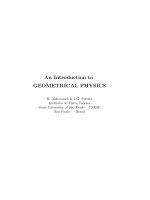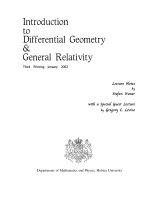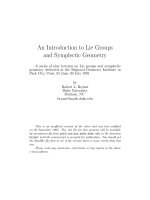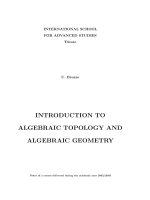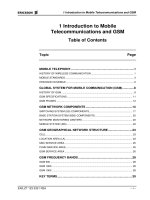- Trang chủ >>
- Khoa Học Tự Nhiên >>
- Vật lý
Introduction to plasma physics and controlled fusion 2nd
Bạn đang xem bản rút gọn của tài liệu. Xem và tải ngay bản đầy đủ của tài liệu tại đây (30.81 MB, 470 trang )
INTRODUCTION TO
PLASMA PHYSICS
AND CONTROLLED
FUSION
SECOND EDITION
Volume 1: Plasma Physics
Francis E Chen
Electrical Engineering Department
School of Engineering and Applied Science
University of California, Los Angeles
Los Angeles, California
PLENUM PRESS
NEW YORK AND LONDON
Library of Congress Cataloging in Publication Data
Chen,
Francis
F., 1929-
lntroduction to plasma physics and controlled fusion.
Rev.
ed.
of: Introduction to plasma physics. 1974.
Bibliography: p.
Includes indexes.
I. Plasma physics.
Plasm-. (Ionized gases) I. Chen, Francis F.,
Contents: v.
I.
1929-
lntroduction to plasma physics. II. Title.
530.4'4
QC718.C39 !983
ISBN 0-306-41332-9
83-17666
10 98 7
This volume is based on Chapters 1-8 of the first edition of
lntroducu·on
ID PlasTTIIJ Physics, published in 1974.
© 1984 Plenum Press, New York
A
Division of Plenum Publishing Corporation
233 Spring Street, New York, N.Y. 10013
All
rights reserved
No part of this book may
be
reproduced, stored in a retrieval
system, or transmitted in any form or by any means,
electronic, mechanical, photocopying, microfilming,
recording, or otherwise, without written permission from
the Publisher
Printed in the United States of America
To the poet and the eternal scholar...
M. Conrad Chen
Evelyn C. Chen
PREFACE
TOT
DITIO
In the nine years since this book was first written, rapid progress has
been made scientifically in nuclear fusion, space physics, and nonlinear
plasma theory. At the same time, the energy shortage on the one hand
and the exploration of Jupiter and Saturn on the other have increased
the national awareness of the important applications of plasma physics
to
energy
production
and
to
the
understanding
of
our
space
environment.
I n magnetic confinement fusion, this period has seen the attainment
of a Lawson number
n-rE
of 2 x 1013 cm-3 sec in the Alcator tokamaks at
MIT; neutral-beam heating of the PLT tokamak at Princeton to KTi
=
6.5 keV; increase of average {3 to 3%-5% in tokamaks at Oak Ridge and
General Atomic; and the stabilization of mirror-confined plasmas at
Livermore, together with injection of ion current to near field-reversal
conditions in the 2XIIB device. Invention of the tandem mirror has
given magnetic confinement a new and exciting dimension. New ideas
have emerged, such as the compact torus, surface-field devices, and the
EBT mirror-torus hybrid, and some old ideas, such as the stellarator
and the reversed-field pinch, have been revived. Radiofrequency heat
ing has become a new star with its promise of de current drive. Perhaps
most importantly, great progress has been made in the understanding
of the M HD behavior of toroidal plasmas: tearing modes, magnetic
Vll
Vlll
Preface to the
Second Edition
islands, and disruptions. Concurrently, the problems of reactor design,
fusion technology, and fission-fusion hybrids have received serious atten
tion for the first time.
Inertial confinement fusion has grown from infancy to a research
effort one-fourth as large as magnetic fusion. With the 25-TW Shiva
laser at Livermore, 3 X l 010 thermonuclear neutrons have been produced
in a single pellet implosion, and fuel compressions to one hundred times
liquid hydrogen density have been achieved. The nonlinear plasma
processes involved in the coupling of laser radiation to matter have
received meticulous attention, and the important phenomena of
resonance absorption, stimulated Brillouin and Raman scattering, and
spontaneous magnetic field generation are well on the way to being
understood. Particle drivers-electron beams, light-ion beams, and
heavy-ion beams-have emerged as potential alternates to lasers, and
these have brought their own set of plasma problems.
In space plasma physics, the concept of a magnetosphere has
become well developed, as evidenced by the prediction and observation
of whistler waves in the Jovian magnetosphere. The structure of the
solar corona and its relation to sunspot magnetic fields and solar wind
generation have become well understood, and the theoretical description
of how the aurora borealis arises appears to be in good shape.
Because of the broadening interest in fusion, Chapter 9 of the first
edition has been expanded into a comprehensive text on the physics of
fusion and will be published as Volume 2. The material originated from
my lecture notes for a graduate course on magnetic fusion but has been
simplified by replacing long mathematical calculations with short ones
based on a physical picture of what the plasma is doing. It is this task
which delayed the completion of the second edition by about three years.
Volume 1, which incorporates the first eight chapters of the first
edition, retains its original simplicity but has been corrected and
expanded. A number of subtle errors pointed out by students and
professors have been rectified. In response to their requests, the system
of units has been changed, reluctantly, to mks (SI). To physicists of my
own generation, my apologies; but take comfort in the thought that the
first edition has become a collector's item.
The dielectric tensor for cold plasmas has now been included; it
was placed in Appendix B to avoid complicating an already long and
difficult chapter for the beginner, but it is there for ready reference.
The chapter on kinetic theory has been expanded to include ion Landau
damping of acoustic waves, the plasma dispersion function, and Bern
stein waves. The chapter on nonlinear effects now incorporates a treat-
ment of solitons via the Korteweg-deVries and nonlinear Schrodinger
equations. This section contains more detail than the rest of Volume
1,
but purposely so, to whet the appetite of the advanced student. Helpful
hints from G. Morales and K. Nishikawa are hereby acknowledged.
For the benefit of teachers, new problems from a decade of exams
have been added, and the solutions to the old problems are given. A
sample three-hour final exam for undergraduates will be found in
Appendix C. The problem answers have been checked by David Brower;
any errors are his, not mine.
Finally, in regard to my cryptic dedication, I have good news and
bad news. The bad news is that the poet (my father) has moved on to
the land of eternal song. The good news is that the eternal scholar (my
mother) has finally achieved her goal, a Ph. D. at
72.
The educational
process is unending.
Francis F. Chen
Los Angeles, 1983
IX
Preface to the
Second Edition
PREFACE
TO THE FIRST
EDITION
This book grew out of lecture notes for an undergraduate course in
plasma physics that has been offered for a number of years at UCLA.
With the current increase in interest in controlled fusion and the wide
spread use of plasma physics in space research and relativistic astro
physics, it makes sense for the study of plasmas to become a part of an
undergraduate student's basic experience, along with subjects like
thermodynamics or quantum mechanics. Although the primary purpose
of this book was to fulfill a need for a text that seniors or juniors can
really understand, I hope it can also serve as a painless way for scientists
in other fields-solid state or laser physics, for instance-to become
acquainted with plasmas.
Two guiding principles were followed: Do not leave algebraic steps
as an exercise for the reader, and do not let the algebra obscure the
physics. The extent to which these opposing aims could be met is largely
due to the treatment of plasma as two interpenetrating fluids. The
two-fluid picture is both easier to understand and more accurate than
the single-fluid approach, at least for low-density plasma phenomena.
The initial chapters assume very little preparation on the part of
the student, but the later chapters are meant to keep pace with his
increasing degree of sophistication. I n a nine- or ten-week quarter, it is
possible to cover the first six and one-half chapters. The material for
XI
Xll
Preface to the
First Edition
these chapters was carefully selected to contain only what is essential.
The last two and one-half chapters may be used in a semester course or
as additional reading. Considerable effort was made to give a clear
explanation of Landau damping-one that does not depend on a knowl
edge of contour integration. I am indebted to Tom O'Neil and George
Schmidt for help in simplifying the physical picture originally given by
john Dawson.
Some readers will be distressed by the use of cgs electrostatic units.
It is, of course, senseless to argue about units; any experienced physicist
can defend his favorite system eloquently and with faultless logic. The
system here is explained in Appendix I and was chosen to avoid
unnecessary writing of
c,
f-Lo, and Eo, as well as to be consistent with the
majority of research papers in plasma physics.
I would like to thank Miss Lisa Tatar and Mrs. Betty Rae Brown
for a highly intuitive job of deciphering my handwriting, Mr. Tim
Lambert for a similar degree of understanding in the preparation of
the drawings, and most of all Ande Chen for putting up with a large
number of deserted evenings.
Francis F. Chen
Los Angeles, 1974
CONTENTS
vii
Preface to the Second Edition
xi
Preface to the First Edition
1
1. INTRODUCTION
Occurrence of Plasmas in Nature
•
Definition of Plasma 3
•
Concept of Tempemture 4
•
Debye Shielding 8
•
The
Plasma Pammeter 1 }
•
C?·iteria for Plasmas 1 1
•
Applications
of Plasma Physics 13
2. SINGLE-PARTICLE MOTIONS
Uniform E and B Fields
Introduction 19
•
B Field 26
•
Nonuniform E Field 36
Field 39
•
Time-Varying B Field 41
•
Center Drifts 43
•
Adiabatic Invariants 43
19
•
19
Nonuniform
Time-Varying E
Summary of Guiding
•
53
3. PLASMAS AS FLUIDS
•
Introduction 53
Relation of Plasma Physics to Ordinary" Electromagnetics 54
The Fluid Equation of Motion 58
•
Fluid Drifts
Perpendicular to B 68
•
Fluid Drifts Parallel to B 7 5
•
The
Plasma Approximation 77
o
Xlll
XIV
Contents
4. WAVES IN PLASMAS
79
•
Plasma
Representation of Waves 79
•
Group Velocity 81
•
Oscillations 82
Electron Plasma Waves 87
•
Sound
Waves 94
•
Ion Waves 95
•
Validity of the Plasma Approxima•
Electro•
Comparison of Ion and Electron Waves 99
tion 98
static Electron Oscillations Perpendicular to B I 00
Electrostatic Ion Waves
•
Perpendicular to B 109
•
The Lower Hybrid Frequency 112
•
ElectTomagnetic Waves with B0 = 0 114
•
Experimental Applica
tions I l 7
122
•
•
Electromagnetic Waves Perpendicular to B0
Cutoffs a.nd Resonances 126
Electromagnetic Waves Parallel to
•
Experimental Consequences 131
Hydromagnetic
Bo 12 8
Waves 136
•
Magnetosonic Waves 142
•
Summary of Elementary
Plasma Waves 144
•
The CMA Diagram 146
155
5. DIFFUSION AND RESISTIVITY
Decay of a Plasma
Diffusion and Mobility in Weakly Ionized Gases 155
•
by Diffusion 159
•
Steady State Solutions 165
•
Recombination 167
•
Difu
f sion across a Magnetic Field 169
•
Collisions in
Fully Ionized Plasmas 176
•
The Single-Fluid MHD Equations 184
Diffusion in Fully Ionized Plasmas 186
•
Solutions of the Diffusion
Bohm Diffusion and Neoclassical Diffusion 190
Equation 188
•
6.
199
EQUILIBRIUM AND STABILITY
The ConIntroduction 199
•
Hydromagnetic Equilibrium 201
•
•
cept of (3 203
Diffusion of Magnetic Field into a Plasma 205
•
Classification of Instabilities 208
•
Two-Stream Instability 211
•
The "Gravitational" Instability 215
•
Resistive Drift Waves 218
The Weibel Instabilit)• 223
7. KINETIC THEORY
225
The Meaning of f(v) 225
•
Equations of Kinetic Theory 230
•
Derivation of the Fluid Equations 236
•
Plasma Oscillations and Landau
Damping 240
•
The Meaning of Landau Damping 245
•
A
BGK and Van Kampen
Physical Derivation of Landau Damping 256
•
Modtts 261
•
Experimental Verification 262
•
Ion Landau Damping 267
•
Kinetic Effects in a Magnetic Field 274
287
8. NONLINEAR EFFECTS
Introduction 287
•
Sheaths 290
•
Ion Acoustic Shock
Waves 297
•
The Pondemmotive Force 305
•
Parametric
Instabilities 309
•
Plasma Echoes 324
•
Nonlinear Landau
Damping 328
•
Equations of Nonlinear Plasma Physics 330
XV
APPENDICES
Appendix A. Units, Constants and Formulas, Vector Relations
Appendix B. Theory of Waves in a Cold Uniform Plasma
Appendix C. Sample Three-Hour Final Exam
Appendix D. Answers to Some Problems
Contents
349
355
36 1
369
Index
417
Index to Problems
42 1
INTRODUCTION TO
PLASMA PHYSICS
AND CONTROLLED
FUSION
SECOND EDITION
Volume t: Plasma Physics
Chapter One
INTRODUCTION
OCCURRENCE OF PLASMAS IN NATURE
It has often been said that 99% of the matter in the universe is in the
plasma state; that is, in the form of an electrified gas with the atoms
dissociated into positive ions and negative electrons. This estimate may
not be very accurate, but it is certainly a reasonable one in view of the
fact that stellar interiors and atmospheres, gaseous nebulae, and much
of the interstellar hydrogen are plasmas. In our own neighborhood, as
soon as one leaves the earth's atmosphere, one encounters the plasma
comprising the Van Allen radiation belts and the solar wind. On the
other hand, in our everyday lives encounters with plasmas are limited
to a few examples: the flash of a lightning bolt, the soft glow of the
Aurora Borealis, the conducting gas inside a fluorescent tube or neon
sign, and the slight amount of ionization in a rocket exhaust. It would
seem that we live in the I% of the universe in which plasmas do not
occur naturally.
The reason for this can be seen from the Saha equation, which tells
us the amount of ionization to be expected in a gas in thermal equilibrium:
n·
�
Here
n;
a nd
nn
=
2.4
X
1021 Jr
3/2
__
e-U;fKT
[1-1]
are, respectively, the density (number per m3) of ionized
atoms and of neutral atoms, Jr is the gas temperature in °K,
K
is
Boltzmann's constant, and U; is the ionization energy of the gas-that
1.1
2
Chapter
One
is, the number of ergs required to remove the outermost electron from
an atom. (The mks or International System of units will be used in this
book.) For ordinary air at room temperature, we may take nn
300°K, and U; = 14.5 eV (for
3 x 1025 m-3 (see Problem 1- 1), T
19
nitrogen), where 1 eV = 1.6 X 10- ]. The fractional ionization n;/(n,. +
n; / n,. predicted by Eq. [ 1- 1] is ridiculously low:
n;)
=
=
=
As the temperature is raised, the degree of ionization remains low
until U; is only a few times
KT.
Then n;/n,. rises abruptly, and the gas
is in a plasma state. Further increase in temperature makes n,. less than
n;, and the plasma eventually becomes fully ionized. This is the reason
plasmas exist in astronomical bodies with temperatures of millions of
degrees, but not on the earth. Life could not easily co�xist with a
plasma-at least, plasma of the type we are talking about. The natural
occurrence of plasmas at high temperatures is the reason for the designa
tion "the fourth state of matter."
Although we do not intend to emphasize the Saha equation, we
should point out its physical meaning. Atoms in a gas have a spread of
thermal energies, and an atom is ionized when, by chance, it suffers a
-
-
-
-
-
-
-
--
FIGURE 1-1
Illustrating the long range of electrostatic forces in a plasma.
collision of high enough energy to knock out an electron. In a cold gas,
3
Int-roduction
such energetic collisions occur infrequently, since an atom must be
accelerated to much higher than the average energy by a series of
"favorable" collisions. The exponential factor in Eq. [ 1- 1] expresses the
fact that the number of fast atoms falls exponentially with U;/ KT. Once
an atom is ionized, it remains charged until it meets an electron; it then
very likely recombines with the electron to become neutral again. The
recombination rate clearly depends on the density of electrons, which
we can take as equal ton;. The equilibrium ion density, therefore, should
decrease with n;; and this is the reason for the factor n � 1 on the
right-hand side of Eq. [ 1- 1]. The plasma in the interstellar medium owes
its existence to the low value of n; (about 1 per em\ and hence the low
recombination rate.
DEFINITION OF PLASMA
Any ionized gas cannot be called a plasma, of course; there is always
some small degree of ionization in any gas. A useful definition is as
follows:
A plasma is a quasineutral gas of charged and neutral particles which
exhibits collective behavior.
We must now define "quasineutral" and "collective behavior." The
meaning of quasineutrality will be made clear in Section 1.4. What is
meant by "collective behavior" is as follows.
Consider the forces acting on a molecule of, say, ordinary air. Since
the molecule is neutral, there is no net electromagnetic force on it, and
the force of gravity is negligible. The molecule moves undisturbed until
it makes a collision with another molecule, and these collisions control
the particle's motion. A macroscopic force applied to a neutral gas, such
as from a loudspeaker generatin� sound waves, is transmitted to the
individual atoms by collisions. The si.tuation is totally different in a
plasma, which has charged particles. As these charges move around, they
can generate local concentrations of positive or negative charge, which
give rise to electric fields. Motion of charges also generates currents, and
hence magnetic fields. These fields affect the motion of other charged
particles far away.
Let us consider the effect on each other of two slightly charged
plasma separated by a distance r (Fig. 1-1). The Coulomb
force between A and B diminishes as l/r2• However, for a given solid
regions of
angle (that is, t1r/r
=
constant), the volume of plasma in B that can affect
1.2
4
Chapter
One
A increases as r3. Therefore, elements of plasma exert a force on one
another even at large distances. It is this long-ranged Coulomb force
that gives the plasma a large repertoire of possible motions and enriches
the field of study known as plasma physics. In fact, the most interesting
results concern so-called "collisionless" plasmas, in which the long-range
electromagnetic forces are so much larger than the forces due to ordinary
local collisions that the latter can be neglected altogether. By "collective
behavior" we mean motions that depend not only on local conditions
but on the state of the plasma in remote regions as well.
The word "plasma" seems to be a misnomer. It comes from the
Greek 1rAacrp,a, -a'To�, 'TO, which means something molded or fabricated.
Because of collective behavior, a plasma does not tend to conform to
external influences; rather, it often behaves as if it had a mind of its own.
1.3
CONCEPT OF TEMPERATURE
Before proceeding further, it is well to review and extend our physical
notions of "temperature." A gas in thermal equilibrium has particles of
all velocities, and the most probable distribution of these velocities is
known as the Maxwellian distribution. For simplicity, consider a gas in
which the particles can move only in one dimension. (This is not entirely
frivolous; a strong magnetic field, for instance, can constrain electrons
to move only along the field lines.) The one-dimensional Maxwellian
distribution is given by
f(u) = A exp (-4rnu2/ KT)
[l-2]
where f du is the number of particles per m3 with velocity between u
and u + du, 4rnu2 is the kinetic energy, and K is Boltzmann's constant,
K
=
1.38 X 10-23 JtK
The density n, or number of particles per m3, is given by (see Fig. 1-2)
n =
t:
f(u) du
The constant A is related to the density
A
=
n
n(21T�T)
[1-3]
by (see Problem 1-2)
1/2
[l-4]
The width of the distribution is characterized by the constant
T,
which we call the temperature. To see the exact meaning of T, we can
f(u)
5
Introduction
u
0
A Maxwellian velocity distribution.
1.
J
compute the average kinetic energy of particles in this distribution:
L:
L./(u.)
�mu2f(u) du
Eav
Defining
v,h
=
= ---:
co :-:-:
---
(2KT/m)112
du
[1-5]
and
[1-6]
we can write Eq. [ 1- 2 ] as
and Eq. [ 1 -5 ] as
Eav =
co
" "
f
co[exp (-y-)]y· dy
3
co
Av,h
exp ( -/) dy
2mAv,h
I
Leo
The integral in the numerator is integrable by parts :
f
co
-co
y· [exp (-y2)]ydy
1[exp
= [-2
=
�
L:
fco
2
co
I exp (-y ) d y
(-y 2)]y]-oo- - -2
co
exp
(-/) dy
Cancelling the integrals, we have
[1-7]
Thus the average kinetic energy is �KT.
FIGURE
1-2
6
Cha·pter
One
It is easy to extend this result to three dimensions. Maxwell's distribu
tion is then
[1-8]
where
A3
3/2
=
[1-9]
n(21T�T)
The average kinetic energy is
We note that this expression is symmetric in u, v, and w, since a Maxwellian
distribution is isotropic. Consequently, each of the three terms in the
numerator is the same as the others. We need only to evaluate the first
term and multiply by three:
Eav
=
2
JJ exp[ -�m(v2 + w2)/ KT] dv dw
9
1
/
9 / KT] dv dw
A3 J exp (-2mu·
KT)du JJ exp[-2m
(v 2 +w·)
1
3A3 J �mu2 exp ( -� mu. / KT)du
Using our previous result, we have
Eav
=
�KT
[1-10]
The general result is that Ea,· equals �KT per degree of freedom.
Since T and Ea.- are so closely related, it is customary in plasma
physics to give temperatures in units of energy. To avoid confusion on
the number of dimensions involved, it is not Eav but the energy corres
ponding to KT that is used to denote the temperature. For KT
1 eV =
=
1.6x 10-19 J, we have
T
=
l.6x 10-19
10-23
1.38 X
=
11,600
Thus the conversion factor is
[1-11]
3 eV in three
By a 2-eV plasma we mean that KT = 2 eV, or Eav
dimensions.
It is interesting that a plasma can have several temperatures at the
=
same time. It often happens that the ions and the electrons have separate
Maxwellian distributions with different temperatures
T;
and T,. This
can come about because the collision rate among ions or among electrons
thPmselves is larger than the rate of collisions between an ion and an
electron. Then each species can be in its own thermal equilibrium, but
7
Introduction
the plasma may not last long enough for the two temperatures to equalize.
When there is a magnetic field B, even a single species, say ions, can
have two temperatures. This is because the forces acting on an ion along
Bare different from those acting perpendicular to B (due to the Lorentz
force). The componetttS of velocity perpendicular to B and parallel to
B may then belong to different Maxwellian distributions with tem
peratures T.1 and Tn.
Before leaving our review of the notion of temperature, we should
dispel the popular misconception that high temperature necessarily
means a lot of heat. People are usually amazed to learn that the electron
temperature inside a fluorescent light bulb is about
20,000°K.
"My, it
doesn't feel that hot!" Of cour!>e, the heat capacity must also be taken
into account. The density of electrons inside a fluorescent tube is much
less than that of a gas at atmospheric pressure, and the total amount of
heat transferred to the wall by electrons striking it at their thermal
velocities is not that great. Everyone has had the experience of a cigarette
ash dropped innocuously on his hand. Although the temperature is high
enough to cause a burn, the total amount of heat involved is not. Many
laboratory plasmas have temperatures of the order of 1,000,000°K
(100 eV), but at densities of 1018-1019 per m3, the he a t i ng of the walls is
not a serious consideration.
1-1. Compute the density (in units of m-3) of an ideal gas under the following
conditions:
{a) At ooc and 760 Torr pressure (I Torr= 1 mm Hg). This is called the
Loschmidt number.
{b) In a vacuum of I o-3 Torr at room temperature (20°C). This number is a
useful one for the experimentalist to know by heart ( 1 0-3 Torr= 1 micron).
1-2. Derive the constant A for a normalized one-dimensional Maxwellian distri
bution
/(u)
such that
= A exp (-mu 2/2KT)
PROBLEMS
8
....,. ,,,..._
_____
Chapter
One
PLASMA
FIGURE
1-3
Debye shielding.
1.4
DEBYE SHIELDING
..,_,.
__
+ + +++
+
++
++
+ +
+ +
++
+ +
+ ++ + + +
+
+
+
A fundamental characteristic of the behavior of a plasma is its ability to
shield out electric potentials that are applied to it. Suppose we tried to
put an electric field inside a plasma by inserting two charged balls
connected to a battery (Fig. 1-3). The balls would attract particles of the
opposite charge, and almost immediately a cloud of ions would surround
the negative ball and a cloud of electrons would surround the positive
ball. (We assume that a layer of dielectric keeps the plasma from actually
recombining on the surface, or that the battery is large enough to
maintain the potential in spite of this.) If the plasma were cold and there
were no thermal motions, there would be just as many charges in the
cloud as in the ball; the shielding would be perfect, and no electric field
would be present in the body of the plasma outside of the clouds. On
the other hand, if the temperature is finite, those particles that are at
the edge of the cloud, where the electric field is weak, have enough
thermal energy to escape from the electrostatic potential well. The "edge"
of the cloud then occurs at the radius where the potential energy is
approximately equal to the thermal energy KT of the particles, and the
shielding is not complete. Potentials of the order of
KT/e
can leak into
the plasma and cause finite electric fields to exist there.
Let us compute the approximate thickness of such a charge cloud.
Imagine that the potential ¢> on the plane x = 0 is held at a value ¢>0 by
a perfectly transparent grid (Fig. 1-4). We wish to compute ¢> (x). For
M/m is infinite,
simplicity, we assume that the ion-electron mass ratio
so that the ions do not move but form a uniform background of positive
charge. To be more precise, we can say that
M/m
is large enough that
9
Introduction
X
0
Potential distribution near a grid in a plasma.
the inertia of the ions prevents them from moving significantly on the
time scale of the experiment. Poisson's equation in one dimension is
(Z
=
1)
[1-12]
If the density far away is nco, we have
ni = nco
In the presence of a potential energy qcf>, the electron distribution func
tion is
f(u)
=A
exp[ -(�mu2 +
qcf> )/ KT,]
It would not be worthwhile to prove this here. What this equation says
is intuitively obvious: There are fewer particles at places where the
potential energy is large, since not all particles have enough energy to
-e, and noting that n, (cf> �
get there. Integrating f(u) over u, setting q
0) nco, we find
=
=
n, =nco exp
(ecf>/ KT,)
This equation will be derived with more physical insight in Section 3.5.
Substituting for ni and n, in Eq. [ 1- 12], we have
In the region where
Taylor series:
iecf>/KT,I
«
1, we can expand the exponential in a
[1-13]
FIGURE
1·4


